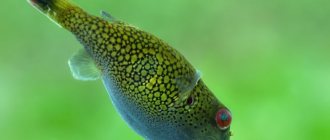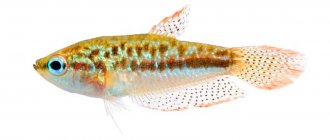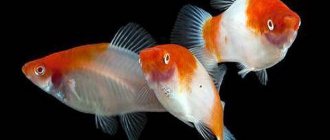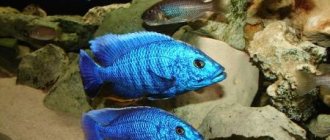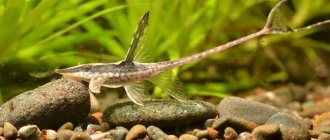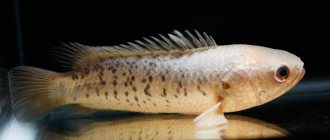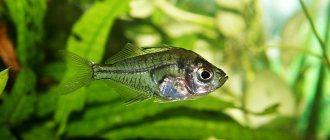Habitat
Widely distributed throughout Southeast Asia in the territory of modern Thailand, Sumatra, Java, Singapore, and Malaysia.
Inhabits slow-flowing water bodies, such as river backwaters, swamps, and lakes with rich aquatic vegetation. Found in brackish coastal waters among mangroves. Brief information:
- Aquarium volume - from 50 liters.
- Temperature - 24–28°C
- pH value – 7.0–8.0
- Water hardness - medium and high hardness (10–20 dGH)
- Substrate type - any
- Lighting - moderate
- Brackish water is acceptable, a concentration of 5 grams of salt per 1 liter of water
- Water movement - moderate
- The size of the fish is 6–7 cm.
- Food - any food
- Temperament - relatively peaceful
- Keeping in a group of 3–4 individuals
Compatibility with other fish in the aquarium
Dermogenis are very fast and agile. Therefore, it is not recommended to add slow fish to them. But despite this, in general they are quite peaceful. Representatives of this species should choose freshwater viviparous fish as neighbors.
The most suitable ones would be:
- Rasbory;
- Pecilia;
- Rainbows;
- Danio;
- Bulls;
- Glass Perches;
- Guppy;
- Mollies;
- Bee gobies.
The last 4 representatives will feel good in salted water. And the lower layers of water, if desired, can be populated with ancistrus and corydoras.
However, large predatory fish cannot be placed with Dermogenis. Otherwise, they will quickly become a delicacy for the new tenant.
Maintenance and care, arrangement of the aquarium
The creation of any special conditions of detention is not required. When designing, it is important to provide open areas for swimming, combined with places for shelter. Clusters of floating plants are used as the latter. The entire surface should not be allowed to become overgrown; this will create difficulties for fish feeding. The design of the middle and lower tier of the aquarium does not matter. Biological balance is maintained by weekly renewal of part of the water (10–20%) with fresh water while cleaning the soil with a siphon from organic residues (excrement, uneaten food residues, plant debris), as well as using a productive filtration system.
Sex differences
Determining the sex of dermogenis is very simple. Females are dense, their abdomen is slightly convex, and the anal fin is fanned out. Males are somewhat smaller, the abdomen is retracted, the anal fin is narrow, its first few rays are transformed into the copulation organ - the andropodium. The fish reach sexual maturity by six months. It is better to keep one male and two or three females. Having noticed that the female’s abdomen has become rounded, it is better to place her in a separate container (8-10 liters, with a water level of 10-12 cm) to produce offspring. Otherwise, the fry will be eaten by the parents themselves or other fish. By the way, these fish are viviparous and give birth to already formed fry.
You can keep it with any peaceful neighbors. Half-snouts simply do not pay attention to fish of other genera (even small ones). A fight can only break out between dermogenis males. Aeration and filtration of water is required, as well as changing it by 1/3 of the volume weekly. The lifespan of dwarf dermogenis is 5 years.
Breeding/reproduction
Females do not lay eggs. Throughout the incubation period, the fry develop in the body of the fish and are born fully formed. This feature has developed evolutionarily as an effective protection for future offspring. Breeding is simple and does not require special conditions; often the aquarist learns about the past spawning post-fate, when the fry are already swimming in the aquarium. It is allowed to be kept with its parents, but for protection it will require reliable shelter in the form of dense thickets of plants, for example, Richia. Feed with small fruit flies and specialized food.
How to distinguish a female from a male Dermogenis semisnout
Let's figure out who is who) Closer to us in this photo is a male, followed by a young lady. The sexes are distinguished by the lower red fins, did you notice that the shape is different? The sexes also differ in “figure”: males are slimmer, but females are much plumper, since they have to bear up to 40 fry. The fish become adults at 3-4 months, reaching a size of 3-4cm.
Let's talk a little about the design of the aquarium. The fish is very shy and stays in the upper layers. Based on this, we draw it up. Free space in the center of the aquarium with thickets of plants on the sides and along the back wall, so that the fish have a place to hide both from each other and from imaginary external threats. The top of the aquarium should be covered with a lid, because... fish are jumping.
These fish are predatory and by nature hunt midges that land on the surface of the water or fly low (hence their jumping ability).
You can feed Dermogenis half-snouts with any medium-sized (important, as they can choke) floating dry food. I feed frozen crushed bloodworms and cyclops; the fish have adapted to catch this food while falling to the bottom. They happily eat floating flakes from the surface and do not disdain small falling granules. In general, we can say that in gastronomic terms they are not picky
Once I caught and fed a moth to the half-snouts, a very, very interesting sight, a whole ritual with tracking, freezing before throwing and attacking. When the time comes for mosquitoes, I’ll make a video about “fish hunting”
Feeding
The aquarium must have a lid. These fish, seeing some kind of midge above the reservoir, are able to jump out after it. Insects are the favorite delicacy of dermogenis. Although they take any food, but only from the surface of the water. If you use bloodworms, dry them for a couple of minutes before feeding - this way they will float on the surface for some time and the fish will be able to easily eat them. Despite the impressive size of the lower jaw, this fish has a small mouth. They are unable to eat large food. The fish readily accept planktonic crustaceans, coretra, and small bloodworms. No tendency to gluttony has been observed in half-snouts.
Reproduction
Dermogenis dwarf reaches its sexual maturity at the age of about 4 months.
These fish belong to the viviparous fish species. All eggs are fertilized and incubated in the abdomen of the female, and during spawning, fully viable fry are born, which immediately begin to swim among the leaves of plants and feed. Fish usually spawn in the same aquarium where they constantly live. The female's pregnancy lasts about 4-6 weeks.
While the eggs are incubating in the female’s body, the water in the aquarium cannot be changed, because the influx of fresh water can contribute to the onset of premature spawning and the fry that are born may have various defects and soon die. It is advisable to transplant the pregnant female, as soon as her anus enlarges, into another aquarium with dense plant vegetation. Usually the female spawns about 30-40 fry. The hatched fry must be immediately transplanted into another aquarium, otherwise the producers may eat them. The fry are fed live dust.
The lifespan of dwarf Dermogenis in aquarium conditions is about 3-4 years.
Diseases
These fish rarely suffer from health problems. Basically, they get sick when their living conditions are violated, as well as from insufficient or improper nutrition. Among the most common problems of Dermogenis dwarf are:
- exhaustion, lethargy;
- parasitic diseases;
- infection.
To prevent diseases, it is necessary to carefully approach the care of the aquarium, regularly check the concentration of various chemical compounds in the water using test strips. It is equally important to monitor the quality of the fish’s diet and be sure to withstand a two-week quarantine for new individuals before moving into a home pond.
Feeding
In natural conditions and their natural habitat, Dermogenis fish eat small insects and their larvae, which are found close to the surface of the water. The creatures' diet also includes other invertebrates.
In terms of keeping at home, the dermogenis fish is unpretentious; any food will suit it, but it is better if its diet includes frozen or live food, that is, flies, moths, mosquito larvae, etc., as well as dry food containing a sufficient amount of protein.
The main feature of feeding fish is that it does not take food in the water column or at the bottom, so when choosing food, keep in mind that the mixtures must be light and floating in order to remain on the surface of the water.
Feeding any fish, including Dermogenis, must be balanced and correct. Try to provide a varied diet, alternating dry and live food. Before you buy food, study the information about what kind of nutrition your fish should have. When it comes to dermogenis, it is important to fill your diet with plenty of protein. The main rule when buying any food is its freshness. Therefore, carefully monitor the production time of food and store it in the required conditions.
Content
When kept in an aquarium, Dermogenis dwarf, as in the wild, prefers to spend most of its time closer to the surface. Therefore, it is not the depth of the container that is important, but the width. It is necessary to have a lid on the aquarium so that the fighting half-snout cannot jump out - this is typical for them due to excessive timidity.
More vegetation is planted around the perimeter so that the fish are not injured by their mouths or beaks on the glass walls. The following plants are suitable for decoration:
It wouldn’t hurt to supplement the aquatic flora with floating algae, but don’t forget to leave an open swimming area in the center. Bottom arrangement is not a fundamentally important aspect and each aquarist chooses the most optimal option.
Aeration and filtration are required. Water changes are carried out once a week. It is recommended to add a little salt - for 10 liters 1 - 2 hours. spoons of sea salt. However, Dermogenis dwarf exists well in fresh environments.
An aquarium is selected with a volume of 60 liters or more; it is better to keep fish in pairs or small groups of 4-6 individuals. Optimal water parameters:
- temperature 20-26 C;
- acidity 6-7 pH;
- hardness 5-15 dH.
It is advisable to illuminate the aquarium with artificial lamps so that the fish do not develop vitamin deficiency. In particular, vitamin D deficiency leads to underdevelopment of fry. As a preventive measure, you can periodically feed animals with this component in oil form, after mixing it with dry food.
Difficulty in content
Dwarf Dermogenis are too shy, especially when there is a sudden change in the surrounding situation or when first introduced into a community aquarium. They begin to rush around and hit the glass. But after some time they calm down and begin to lead a measured life, without causing any problems in their care.
Compatibility with other types
Despite the pugnacity of males, the half-snout calmly gets along with peaceful and small fish, especially if they do not have to share the upper layers of water. Catfish and fish living in the middle layers will be excellent neighbors. They won't be bored alone either.
In a fresh aquarium, the best neighbors will be rainbowfish, gobies, and rasboras. If the water is salted, then other companions are selected - glassy perches, gobies - bees, mollies.
How, where, when and what to fish for Spitz fish
The Spitz is a small, peace-loving fish. Schools of this fish approach coastal zones at the end of autumn and stay in such places until the spring warms up. This behavior is due to cooling water temperatures in deep-sea areas and the lack of food. In warm weather, flocks go to sea. Such migration of the family does not allow for a stable bite. When fish move a considerable distance from the shore, fishing is preferable on boats.
5.1 Biting calendar - at what time of year and day does the Spitz bite best?
Pomeranian fishing can be done year-round, but fishing from the shore will be most successful between September and May. The rest of the time, there may also be a bite, but not as active.
Fish activity is observed at dawn and sunset, namely in the morning hours from 5.00 to 8.00. In the evening - from 17.00 to 19.00 hours, it all depends on the daylight hours. Activity is often observed at night.
Video: duration 2.23 sec. Fishing for Spitz in the Mediterranean Sea with a bombard
5.2 In what weather does a Spitz bite best?
Moderate weather conditions and small waves allow for good results. If you have more accurate information, I would be very grateful if you share it in the comments to this article.
5.3 What are the best places to catch Spitz (half-snout)
Spitz is a schooling fish that lives near the seashore, in places rich in algae.
5.4 What gear to use for catching half snout
The length of the rod and how it is equipped depend on weather conditions and the preferences of the fisherman.
How to choose the best spinning rod for jigging - read here
Option 1 For fishing in the Mediterranean, a spinning or fly rod with a length of up to 5 m and a cast of 20–100 g is suitable.
Next we equip:
- “Buldo” float through (a transparent empty ball that is filled with water to half the float for its flight range) with a load of 30 - 60 g;
- we thread a fishing line with stoppers at a distance of 30 to 40 cm, and a float between them;
- a leash is tied to the lower stopper;
- with a blind float, 1 – 2 leashes up to 2 m long are knitted;
- Due to the casting range, it is better to use a medium-sized spinning reel to quickly land fish.
In this section you will find detailed information about what a spinning reel is and what a multiplier reel is, how they differ and how to choose the right one.
Option 2 Bolognese rod up to 7 m long:
- float 1 – 2 g;
- main line 0.17-0.20 mm;
- fluorocarbon leash 40-50 cm long, up to 0.14 mm in diameter;
- hook No. 10 or 12;
So that you don’t have to waste time and delve into the wilds of Aliexpress, for your convenience we have made a selection of the most delicious offers for the sale of fishing accessories with the best price offers and reviews.
Who doesn't know yet? You can return up to 15% of the price of your purchase on aliexpress. In addition to Aliexpress, the possibility of cashback (returning part of the money) also works for many other online stores. Here is a detailed description of this service and everything about how to work with it. It really works and helps you save a lot of money. The cashbacker website often runs promotions that allow you to buy goods at a discount of up to 90%.
Option 3
- sbirulino float (bombard) from 30 to 40 g (for casting distance);
- leash 1 – 1.5 m;
- hook number 8.
Option 4 Bottom tackle, two leashes, and behind them a sliding load from 20 to 30g.
Video: duration 5.36 seconds. Catching a Spitz from a kayak on a bombard
5.5 Bait for catching half-snout
They say you can try using bread crumbs.
5.6 What baits and baits does the Spitz (half-snout) bite on?
Animal attachments:
- squid pieces;
- shrimp pieces;
- worm (crawl, sandworm, pieces of dendrobena);
- Nereis sea worm.
Read the most interesting things about experiments testing the dendrobena worm while fishing in Israel - here
Plant attachments:
- viscous and soft dough.
5.7 How does a Spitz (half-snout) fish bite?
Hooking the fish should be sharp, but at the same time not forceful. Due to the long fishing distance, the bite is felt weakly. By twitching the tip of the tackle, you can increase the sensitivity of the bite. When swallowing a hook, the Spitz jumps out of the water up to 1.5 m in height and strongly resists. Therefore, fishing must be done slowly.
5.8 How to fish correctly? – Basic techniques
When fishing from the shore, the main condition for successful fishing is casting. It must be done at the maximum possible distance.
Detailed information about fishing with the jig technique: features, advantages, tips, types of catchable fishing, a review of jig baits, a lot of videos and other useful information - read here
5.9 The most important points when catching Spitz (half-snout)
- choose equipment depending on weather conditions, behavior of water and wind;
- use weighted equipment for casting distance from the shore;
- the cutting must be sharp.
